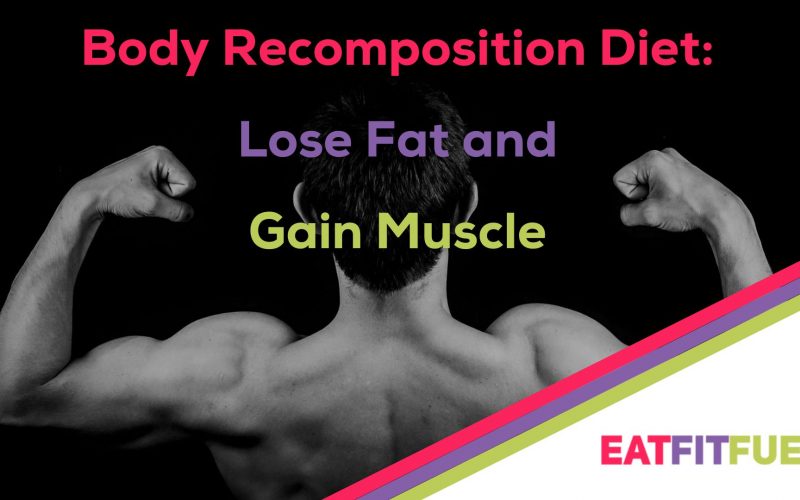Many people are trying to lose weight, rock hard-abs, and look lean all over. Generally, men aim at having a body fat of 10%, while women are recommended to have a body fat of sub-12%.
The concept of body recomposition, though enticing, has always been misunderstood. That’s why we’ll be exploring the science behind it in this article and how to effectively implement a body recomposition diet and exercise plan.
Overview
What is Body Recomposition?
Understanding Body Recomposition
Strategies for Effective Body Recomposition
The Science of Body Recomposition
Dietary Approaches for Body Recomposition
Exercise Recommendations for Body Recomposition
Body Composition Assessment Methods
Conclusion
Frequently Asked Questions
What is Body Recomposition?
We’ll start by talking about what body composition is to understand body recomposition. Body composition is the balance of lean mass and fat mass that make up a person’s body weight. A person may, for instance, weigh 150 pounds but have a body fat of 22%, meaning they have 117 pounds of lean mass and 33 pounds of fat mass.
The thing about body composition is that although someone else may have the same height and weight as you, they might have more body fat and less muscle, possibly leading to some health issues.
Body recomposition is the simultaneous loss of fat and the building of muscle while maintaining a fairly stable body weight. It focuses on the body’s composition rather than weight. It’s a lifestyle in which fitness and nutritional techniques result in beneficial changes in the body’s ratio of fat to muscle.
Body recomposition is different from the traditional approach of bulking up and later cutting down, which focuses on muscle gain or fat loss in isolation. The appeal of body recomposition is the likelihood of getting leaner and muscular all at the same time.
Understanding Body Recomposition
Body recomposition is a fitness goal focused on enhancing your body composition. Instead of setting goals based on body weight, body recomposition goals center on a lean body mass and fat. These two are the main contributors to the weight and how they compare to each other.
But apart from knowing your body weight, you may want to check on factors like body fat mass, lean body mass, and your percentage of body fat.
If you’re focused on body recomposition, chances are that you’ll set your goals around reaching certain body composition milestones. This might include minimizing your body fat percentage and increasing your muscle mass. Compared to weighing yourself, you might start noticing the results by taking body measurements, as muscle tissue is denser than fat.
Note, body recomposition progress doesn’t necessarily reflect on the scale as it is a more holistic way of approaching fitness. It takes your physical appearance and how you feel into account with the right diet, exercise regimen, and physiological profile. It’s also important to note that body recomposition is possible in contexts such as:
Newbie gains: People who are new to strength training often experience muscle growth coupled with fat loss. That’s especially true in the first 3-6 months of training.
Returning to training: Those returning to their physical exercise routine after a layoff. They can regain muscle mass while shedding fat.
Metabolic advantages: Young people and those with more muscle mass tend to have an easier time with body recomposition.
Caloric manipulation: Strategic adjustments to calorie intake and expenditure help to promote muscle gain and fat loss.
9 Strategies for Effective Body Recomposition
Successful body recomposition requires a multi-faceted approach, including diet, exercise, and lifestyle changes. The following are 9 effective strategies for body recomposition:
- Follow a high-protein diet: Set your protein intake at 1.6-2.2g per kg of body weight. Remember that high protein levels preserve muscle and increase thermogenesis.
- Cycle calories: Alternate periods of calorie surplus and deficit of 10-20% outside your maintenance calories. This serves to stimulate muscle growth during surpluses and fat loss during deficits.
- Lift heavy weights: Compounding exercises using heavy weights helps to maintain muscle mass. This includes movements like squats, deadlifts, and even presses.
- Include cardio: Do 2-4 sessions of cardio per week to increase fat loss. You should opt for HIIT or steady-state endurance exercise, depending on your preference.
- Get enough rest and sleep: It’s recommended you get 7-9 hours a night to support muscle growth and fat metabolism through hormonal regulation.
- Manage stress: High cortisol can impede efforts. You can take part in yoga, meditation, or other strategies to control your stress levels.
- Track everything, including your progress: Monitor your nutrition, training, sleep, stress, and progress through journaling. You can also take photos, do body measurements, and body composition testing.
- Consistency: It’s important to note that body recomposition is not a quick fix but a long-term strategy.
- Patience: Patience is key for anyone who wants to achieve their fitness goal. That’s because body recomposition is slow and takes time. As such, you must be patient while at it to see the changes.
The Science of Body Recomposition
When you start your fitness journey, chances are your long-term goal will involve muscle gain and loss of fat. However, conventional wisdom suggests that you focus on one goal at a time, just like is the case with dietary recommendations in terms of gaining muscle and losing fat.
So is it really possible to achieve muscle gain and lose fat at the same time? The fact is, yes, body recomposition can occur. This happens in the context of skeletal muscle hypertrophy and concomitant adipose tissue loss. Below are some scientific proofs to prove that possibility:
Muscle protein synthesis: Consuming protein stimulates MPS and helps to build and maintain muscle, even in cases of calorie deficits.
Fat mobilization: Catecholamines from exercise serve to mobilize fatty acids for use as energy while lowering your insulin levels.
Anabolic hormones: Weight training helps to boost testosterone and growth hormone for muscle growth.
Calorie partitioning: More calories are especially used to build muscle instead of getting stored as fat.
Nutrient repartitioning: Proteins and other nutrients are directed towards muscle tissue under exercise stimuli.
Dietary Approaches for Body Recomposition
Effective body recomposition requires a good combination of exercise and diet. Diet provides the raw materials used to build muscle and shed fat. Consuming the right foods in the right amounts is important for successful body recomposition. Here’s what to focus on to support body recomposition:
Eat enough protein: Aim for 1.6-2.2g of protein per kg of body weight daily from high-quality sources. These sources include lean meats, dairy, eggs, and seafood.
Healthy fats: Around 30% of calories from unsaturated fats help with the production of hormones and the absorption of fat-soluble vitamins.
Eat enough carbohydrates: Carbohydrates provide energy to the body to fuel workouts. Thus, you must consume around 2-3g per kg of carbs from fruits, veggies, whole grains, and tubers.
Manage calorie intake: Use calorie cycling strategically with periods of slight surplus and slight deficit. This helps to spur muscle growth and fat loss.
Balancing micronutrients: Eat a nutritious, whole-food diet. Ensure that it’s rich in vitamins, minerals, and phytonutrients. You must also consider a multivitamin to fill any gaps.
Staying hydrated: Take enough water and limit beverages with added sugars, as good hydration supports muscle and metabolic function.
Exercise Recommendations for Body Recomposition
Building muscles and burning fat are the core aspects of body recomposition. It may be that you want to have a body like that of a goddess or something in between.
Whatever the case, body recomposition exercises are a must. So, your workouts must focus on a combination of strength and cardio programs for muscle growth and the enhancement of fat loss.
- Strength Training
Train each major muscle group for 2-3 times per week.
Include compound lifts like squats, deadlifts, presses, rows, and pull-ups.
Be sure to use challenging weights and minimal restful periods.
Include isolation exercises for focused development.
Allow your body to get adequate recovery between intense sessions.
- Cardiovascular Training
Perform 2-4 cardio sessions every week on non-consecutive days.
Choose from a steady state like walking, jogging, or high-intensity interval training.
Start with 20-30 minutes while building up to 45-60 minutes for every session.
Maintain a challenging pace to improve the heart rate and burn more calories.
Tracking Progress of Body Recomposition
To stay on track with your body recomposition goals, it’s important you monitor the following:
Body weight: Weigh yourself under constant conditions in the morning and start noting the changes over weeks and months.
Body measurements: Measure the chest, arms, waist, hips, and thighs with a tape measure to detect body changes.
Body fat percentage: Use skinfold measurements, bioelectrical impedance, or DEXA scans to gauge fat loss in the body.
Muscle size: Measure specific body parts such as the biceps, quads, or calves with a tape measure.
Performance metrics: Benchmark strength levels, workout volume, and cardio capacity and note improving numbers because they are an indication of progress.
Take progress photos: Take monthly front, back, and side photos in consistent poses and lighting.
Nutrition tracking: Use an application to ensure that you get it right with protein targets and your calorie cycling goals.
Body Composition Assessment Methods
To properly track loss of fat and muscle growth, take advantage of the following body composition testing techniques:
Hydrostatic weighing: Consider the gold standard, which submerges you to measure body density and calculate your body fat percentage.
DXA scan: Make use of dual-energy X-rays to differentiate fat mass, lean body mass, and bone mineral density with a high degree of accuracy.
Air displacement plethysmography: Use it to measure the body volume and determine fat and lean tissue mass through machines like the BOD POD.
Ultrasound: It helps to tell the subcutaneous fat layers and muscle thickness of specific body parts like the abdomen or quads.
Bioelectrical impedance: Through this method, a small electrical signal is passed through the body to estimate total body water, fat mass, and fat-free mass.
3D body scanners: They provide measurements similar to tape measurements digitally through devices like the Fit3D Pro scanner.
Skin fold calipers: They’re used at key sites to estimate the body fat percentage depending on the thickness of subcutaneous fat.
Conclusion
Body recomposition is a goal many people would love to achieve for aesthetics, better health, and fitness. Achieving simultaneous fat loss and muscle gain is an ambitious yet achievable goal. Awareness, maintaining a positive mindset, staying motivated, and having sustainable habits will lead to your desired results in the long term.
Following a high protein diet, implementing calorie cycling, lifting weights, and adding in cardio can alter body composition in your favor, leading to successful body recomposition. And if you need guidance, consider consulting a professional to help you reach your goals. Keep in mind that body recomposition takes time, commitment, and a holistic approach.
Frequently Asked Questions
How long does it take to notice the results?
Depending on individual factors, noticeable changes can be observed between a few weeks and a couple of months.
Does one have to follow a specific diet?
There’s no one-size-fits-all diet when it comes to body recomposition. However, a well-balanced nutrition plan that’s set at the right individual calories with adequate protein, carbohydrates, and healthy fats is important.
What kind of exercises should a person focus on for body recomposition?
An integration of resistance training and cardiovascular exercise is recommended to help stimulate the body’s muscle growth and boost the loss of fat.
Is body recomposition suitable for everyone?
It can be pursued by people of various fitness levels and body composition. However, it would be important to consult a professional before starting.






